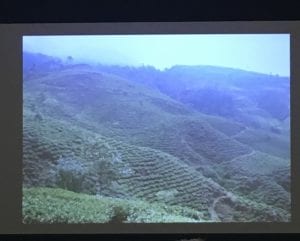On Tuesday of last week I decided to go and hear Sarah Besky’s discussion on what she called “Spaces for Labor.” I knew that this lecture had something to do with tea but I assumed it would be about either the production of tea or about the economics of tea. However, what I stumbled into was not a discussion on either of these options but rather was a talk about tea plantations and worker compensation. Looking back and noting the title, I should have known that this talk pertained to “labor,” yet I did not make this connection until I was already listening.
Within this lecture, Besky explained the peculiar position that cultivators of tea are in. Her main purpose in this lecture was to demonstrate that the compensation and inheritance structures apparent within Darjeeling are facilitating a system of marginalization that is tolerable within society. In order to explain this, Besky first delved into the history of “family garden farming” and the colonial “improvement” projects used by Britain to exploit the populace and create efficient laborers. She then described the process of giving houses to these laboring families and their familial structure of inheritance. This process of inheritance in turn creates a system of exploitation on the plantation. Technically these houses can never be owned by the laborers, yet they end up using all of their small bonuses on upkeep of the house. Even though the plantation is mandated to maintain the house (after the Plantations Labour Act of 1951) workers are expected to maintain their own homes by using their bonus. For example, if a roof gets a leak an individual has to use their bonus to fix it rather than the plantation fixing it. Besky further argued that this compensation structure creates an attachment to the system. The act of domestic inheritance in itself is an act of appropriation and ultimately creates “spaces for labor” not spaces of labor.
For me, even though I drink a good amount of tea, I had never actually asked myself about tea plantations and the workers that were involved in the process of harvesting tea –leaves. I knew tea was a large part of the Indian economy, however, I did not realize that India was the world’s second largest exporter of tea after China. Specifically, West Bengal, and Darjeeling specifically, is a large producer. Darjeeling is one of the more productive tea harvesting areas with 8.42 million kilograms of output in 2014 alone. Also, the amount of land used for tea cultivation in this area is around 17,500 hectares of land, an enormous amount equating to about 43,243 acres (http://www.thehindu.com/business/Industry/dip-in-darjeeling-tea-output-likely/article7418050.ece). With this amount of output and land used for cultivation purposes one would assume that the Indian government pays more attention than they do to the conditions these citizens are in. However, it is hard to regulate this compensation structure. India has a long way to go before working conditions and compensation practices improve.
This lecture was definitely eye-opening, yet not the most enjoyable. I found her topic very interesting, but I was not entirely enthralled. Furthermore, sometimes she contradicted herself and was then forced to backtrack in order to provide clarity (this was much more prevalent in the latter portion of the question session). Overall I am glad I went to this presentation as it shed much needed light on a topic that I have not heard much about. While the presentation could have been better the material was interesting.
Patrick Hosch
Sources:
http://www.thehindu.com/business/Industry/dip-in-darjeeling-tea-output-likely/article7418050.ece
https://books.google.com/books?id=RcIBAgAAQBAJ&pg=PA139&lpg=PA139&dq=India+tea+production+and+ties+to+land&source=bl&ots=Zxv4HFaw1k&sig=raqSZ2x4vwUHlYqTLH0rqzEqW6k&hl=en&sa=X&ved=0ahUKEwjt9qjwhpzMAhXDZCYKHe3CB6cQ6AEIMDAD#v=onepage&q=India%20tea%20production%20and%20ties%20to%20land&f=false


